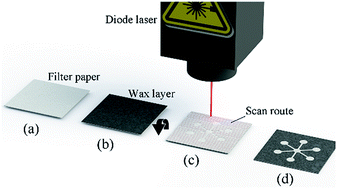Laser-induced selective wax reflow for paper-based microfluidics
Abstract
This study proposes a novel method for the fabrication of paper-based microfluidic devices using laser-induced selective thermal reflow for wax penetration. A layer of wax was evenly deposited on the front side of a filter paper; then a low-cost diode laser was used to scan the designed area from the back side of the filter paper. At the laser irradiated spot, the wax was heated, melted down and penetrated through the whole thickness of the filter paper, and formed hydrophobic barriers on the hydrophilic cellulose fibers. The patterned hydrophobic wax barriers on the filter paper defined the flow path of the fluid for the paper-based microfluidic device. Compared with conventional two-step (deposit and reflow) approaches for paper-based microfluidics using wax barriers, e.g. wax printing, stamping or photolithography, the proposed fabrication protocol achieved wax patterning and reflow simultaneously, conducted during the laser scan process, and without the requirement for any sophisticated instruments or a cleanroom environment. A series of tests were also conducted for the characterization of the proposed paper-based microfluidic device fabrication technique. The fabrication technique used in this approach could have broad application potential in point-of-care diagnosis and testing, especially for applications in the developing world.



 Please wait while we load your content...
Please wait while we load your content...